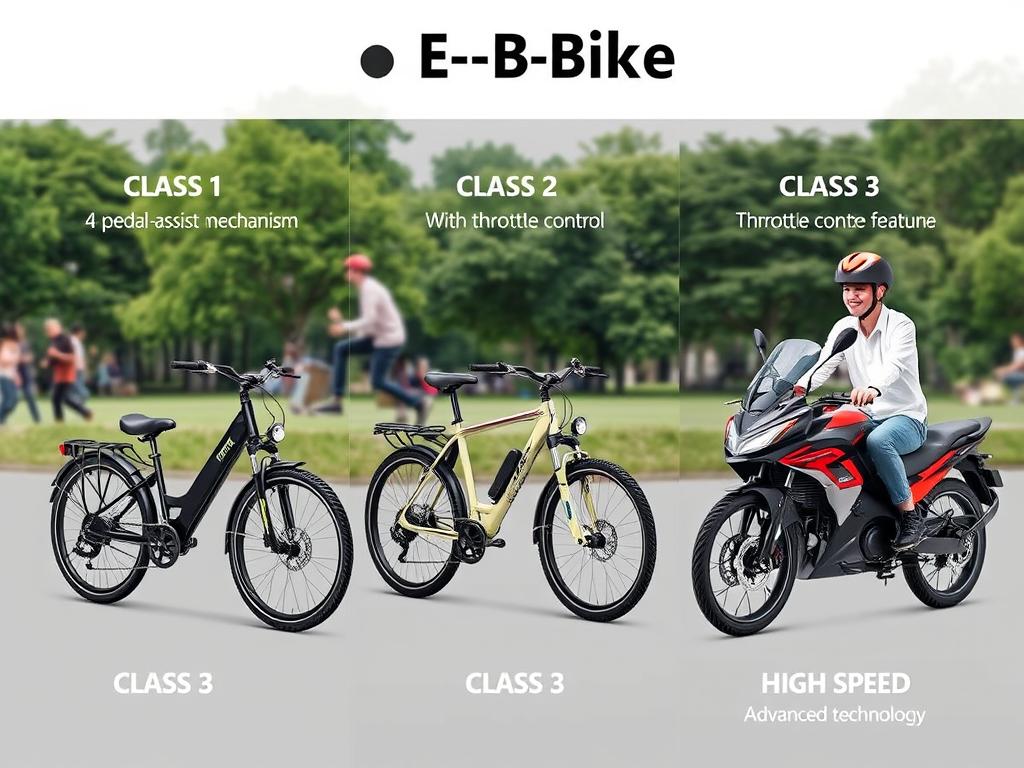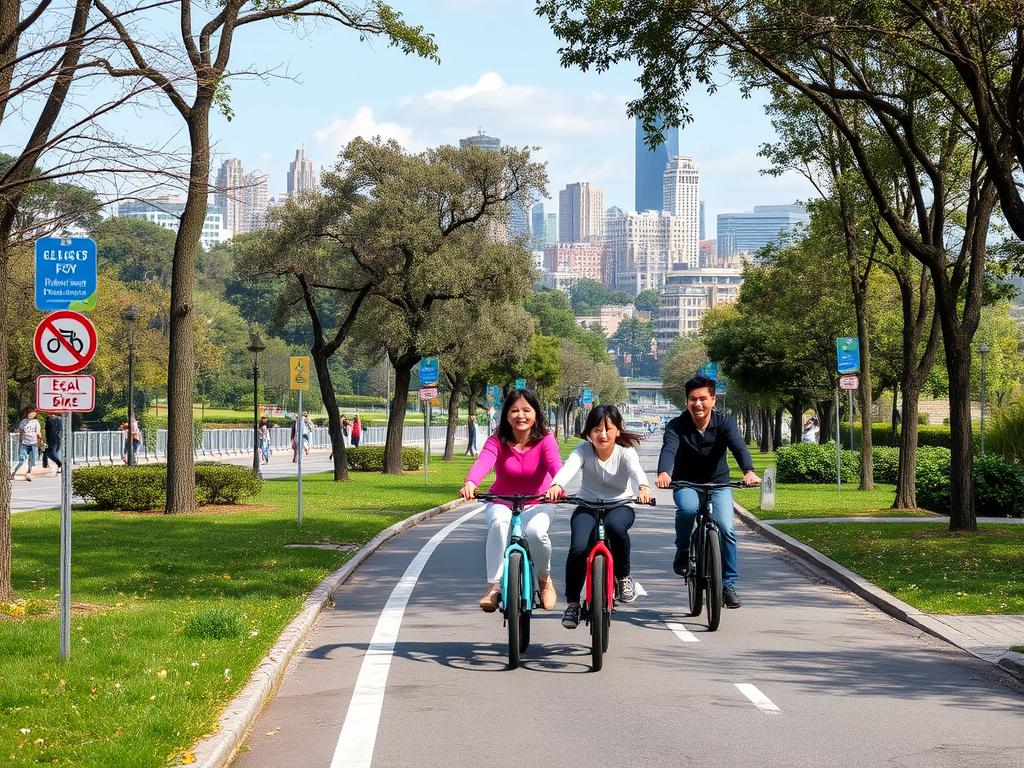The United States has a diverse landscape when it comes to electric bicycle (e-bike) laws and regulations. Currently, 44 states have set their own rules for e-bikes. 38 states use a 3-tiered system to classify them. These rules aim to keep riders safe and lower accident rates.
Federal guidelines say e-bikes are “low-speed electric bicycles” with pedals that work. They have motors under 750W and can’t go over 20 mph on their own. But, each state can make its own laws, creating a mix of rules across the country.
It’s important for family e-bike fans to know the laws. This section will look at state laws and federal guidelines. We’ll help you understand the complex world of e-bike rules in the USA.
Key Takeaways
- 44 states have established definitions for e-bikes, with 38 states adopting a 3-tiered classification system.
- Federal guidelines define e-bikes as “low-speed electric bicycles” with a maximum speed of 20 mph when powered solely by the motor.
- State-specific laws and regulations vary widely, leading to a patchwork of rules across the country.
- Understanding e-bike laws is crucial for family e-bike enthusiasts to ensure safe and legal riding practices.
- This section will explore the complexities of e-bike legislation in the USA, including federal guidelines and state-specific regulations.
Understanding e-Bikes and Their Classifications
In the world of bicycles, a new category has emerged – the electric bicycle, or e-bike. These innovative vehicles combine the traditional bicycle design with an electric motor. This gives riders a versatile and efficient mode of transportation. It’s important to explore their classifications and how they differ from traditional bicycles.
Definition of e-Bikes
An e-bike is a bicycle with an electric motor that powers the wheels. This motor can help the rider pedal or move the bike without pedaling. E-bikes come in various designs and features to meet different riding needs.
Class 1, 2, and 3 e-Bikes
- Class 1 e-Bikes have a motor that only works when pedaling, with a top speed of 20 mph.
- Class 2 e-Bikes have a throttle-actuated motor for moving without pedaling, also with a top speed of 20 mph.
- Class 3 e-Bikes offer pedal-assist up to 28 mph, making them the fastest.
These classifications help determine the appropriate usage and regulations for different types of e-bikes. They can have varying impacts on safety and infrastructure.
Differences Between e-Bikes and Traditional Bicycles
E-bikes have an electric motor, unlike traditional bicycles. This motor provides extra power, allowing riders to travel farther with less effort. However, this also means e-bikes may face additional regulations and requirements, depending on their class and the laws in the rider’s location.

Understanding the different classifications of e-bikes and how they compare to traditional bicycles is crucial. It ensures riders use their vehicles safely and in compliance with the law.
Federal Regulations on e-Bikes
In the United States, the federal government has set rules for electric bicycles (e-bikes). These rules, based on the Consumer Product Safety Commission (CPSC), help keep e-bikes safe and well-used everywhere.
Overview of Federal Guidelines
The CPSC calls e-bikes “low-speed electric bicycles” under the Consumer Product Safety Act. This rule makes sure e-bikes are safe to use. It requires e-bike makers to follow certain safety standards.
The Consumer Product Safety Commission (CPSC) Role
The CPSC is key in setting federal e-bike regulations. They make rules that e-bike makers must follow. This ensures e-bikes are safe and work well.
Federal Electric Bike Laws
At the federal level, national electric bicycle laws limit e-bike power to 750 watts. They also cap the speed at 20 mph when using the electric motor only. But, states can make their own rules, which might be different from the CPSC guidelines.

The rules on e-bikes aim to find a good balance. They want e-bikes to be easy to use, safe, and good for the environment. By making e-bikes similar to regular bikes, they hope to encourage more people to use them instead of cars.
State-Specific e-Bike Laws
In the United States, e-bike laws vary from state to state. By July 2023, 38 states use a 3-tiered system to classify e-bikes. This system defines their speed and power. But, each state has its own rules, making it crucial for riders to know the local laws.
Overview of State Regulations
Most states follow the 3-tiered Class 1, 2, and 3 system. But, some states have made their own changes. For example, New York limits Class 3 e-bikes in big cities to 25mph. Alaska and Hawaii have their own rules that are different from the standard system.
Notable Variations in State Laws
- Helmet laws vary: Alaska and Massachusetts don’t require helmets, but Hawaii does for those under 16.
- Age limits differ: Kentucky has no age limit, but North Carolina requires riders to be at least 16.
- Registration and licensing: Massachusetts needs an operator’s license, and Hawaii requires registration for fast e-bikes. Kentucky and North Carolina don’t need these.
- Insurance rules: Kentucky and Montana don’t require insurance, but other states might have specific rules.
States with Comprehensive e-Bike Legislation
Some states have detailed laws about e-bikes. California, Colorado, and Michigan have rules on classifications, speed, and trail access. These laws help ensure safe and legal use of e-bikes.
“The patchwork of e-bike laws across the United States underscores the importance for riders to stay informed and comply with the specific regulations in their state and local jurisdictions.”
Knowing the specific laws in your state helps riders use e-bikes safely and legally. It also lets them enjoy the benefits of this popular mode of transportation.
Local Ordinances Affecting e-Bikes
Federal and state laws set rules for electric bicycles. But, local rules can add more restrictions. These rules can change a lot from one place to another. Riders need to know these rules to follow the law.
How Local Laws Can Vary
Some cities ban e-bikes on bike paths or trails. Others let them. New York City has its own rules for e-bikes, different from state laws. The City of Boulder, Colorado has special rules for electric bikes too. It’s important to know both state and local laws, as they can change a lot.
Examples of City-Specific Regulations
- In Oregon, the state has laws for e-bikes. But, the City of Eugene has its own rules too.
- The Province of Ontario and City of Toronto in Canada have their own e-bike rules. These rules might be different from federal laws.
- The State of Michigan is pretty open to e-bikes. But, Ann Arbor has its own local rules.
Importance of Checking Local Laws
E-bikes are getting more popular. So, local rules for e-bikes are changing too. Riders need to keep up with these changes. This way, they can ride their e-bikes legally and safely.

“The patchwork of e-bike regulations across the country can be confusing, but it’s essential for riders to understand the local laws in their area to avoid any legal issues.”
Age Restrictions for e-Bike Riders
Electric bicycles (e-bikes) are becoming more popular. It’s key for riders to know the age rules and safety tips. Age limits for e-bikes vary in the U.S., depending on the bike’s class.
General Age Guidelines
Most states set a minimum age for e-bike riders, especially for Class 3 bikes that go up to 28 mph. The age range for Class 3 e-bikes is usually 14 to 16. But, some places like California and Connecticut let younger kids ride as passengers on Class 3 e-bikes.
State-Specific Age Requirements
- Alabama lets 14-year-olds with a class M driver’s license ride motor-driven cycles.
- California doesn’t treat e-bikes as cars, so no permits or licenses are needed.
- Georgia doesn’t need licenses or registration for e-bikes. Riders under 16 must wear helmets, and Class 3 e-bikes require a minimum age of 15.
- Illinois doesn’t require licenses or registrations for e-bikes. Riders under 16 can’t ride Class 3 e-bikes.
- Massachusetts requires an operator’s license and registration for e-bikes. Riders must be at least 16 years old.
Safety Measures for Young Riders
Many states have safety rules for young e-bike riders. These include wearing helmets and not riding on certain paths or roads. For example, in California, Class 3 e-bike riders must be 16 or older. Riders under 17 must wear helmets.
As the e-bike market grows, it’s important for young riders to know the latest rules. By following age limits and safety tips, e-bike fans can enjoy these green vehicles safely.
Helmet and Safety Gear Laws
As electric bicycles (e-bikes) become more popular in the United States, it’s key for riders to know the laws about helmets and safety gear. The rules for e-bike safety can change a lot, and knowing them helps make sure your rides are fun and safe.
Are Helmets Required for E-Bike Riders?
In the USA, helmet laws for e-bike riders vary. Some states require helmets for everyone, while others have looser rules. Right now, 25 states and Washington, D.C. say you need a helmet to ride an e-bike. The rules often depend on the e-bike’s class, with Class 3 e-bikes facing stricter rules.
Recommended Safety Gear for E-Bike Riders
- High-visibility clothing, such as bright or reflective outerwear, to increase your visibility to other road users
- Gloves to provide grip and protection for your hands
- Appropriate, closed-toe footwear to ensure stability and safety while riding
Local Variances in Helmet Laws
Some states have helmet laws for everyone, but others let local areas decide. It’s vital to check the laws in your city or county, as they might be stricter than state laws. For instance, in California, Class 3 e-bike riders must wear helmets, but local rules might add more requirements.
It’s important for e-bike riders in the USA to follow helmet and safety gear laws. By focusing on your safety, you can enjoy e-bikes more while also setting a good example. This helps make e-bikes a safer, greener way to get around.
Registration and Licensing Needs
E-bikes have different rules for registration and licensing in the U.S. Most states don’t need you to register or license e-bikes that follow federal rules. But, some places treat e-bikes like cars or mopeds.
Do You Need to Register Your e-Bike?
Low-powered e-bikes that follow federal rules are usually not registered. But, Hawaii requires e-bike registration with a fee of $10 to $30. E-bikes with more power or speeds over 28 mph might need to be registered in some states.
States Requiring Licenses for e-Bike Use
- In Alaska, any bike with a motor is a motor-driven cycle. You need a class M driver license to ride it.
- Connecticut lets e-bikes go up to 30 MPH. You need a Driver’s License and must wear a helmet if you’re 15 or older.
- In Massachusetts, e-bikes can go up to 25 MPH. You must have an operator’s license and register your e-bike.
- New Mexico sees e-bikes as “mopeds.” Riders must be 15 or older, have a license, and insurance.
Consequences of Non-Compliance
Riding an unregistered e-bike can result in fines, especially for powerful ones. But, many states are making e-bike rules clearer. It’s important to check the e-bike registration requirements, electric bicycle licensing, and e-bike legal compliance in your area.
Insurance Considerations for e-Bikes
Electric bicycles (e-bikes) are becoming more popular in the United States. This has raised questions about insurance for these vehicles. Most states don’t require insurance for e-bikes, but some riders choose to insure them. Homeowners or renters insurance may offer some protection, but specialized e-bike insurance is also available. It provides full coverage, including liability protection.
Do You Need e-Bike Insurance?
Whether you need e-bike insurance depends on your personal preferences and local laws. Some riders get insurance to protect against accidents, theft, or damage. However, insurance options and requirements vary by region.
Options for Insuring Your e-Bike
- Homeowners or renters insurance: Some policies may cover e-bikes, but coverage is often limited.
- Specialized e-bike insurance policies: These offer more comprehensive coverage, including liability and theft protection.
- Bicycle-specific insurance: Some providers offer e-bike coverage with customizable plans.
Benefits of Carrying e-Bike Insurance
Carrying e-bike insurance policies provides financial protection against accidents, theft, or other unexpected events. Electric bicycle coverage offers peace of mind and helps cover repair or replacement costs. Some e-bike insurance policies also include liability coverage, protecting riders in incidents involving others.
“As the e-bike market continues to grow, it’s important for riders to consider the insurance options available to them to ensure they are adequately protected,” says an industry expert.
While e-bike insurance policies vary in requirements and availability, understanding your options is key. It helps riders make informed decisions about protecting their e-bikes.
Tips for Staying Compliant with e-Bike Laws
To keep up with e-bike laws in the U.S., it’s key to check for updates often. About 30 U.S. states have different rules for electric bikes. PeopleForBikes offers guides on e-bike laws, safety, and more to help you.
Following traffic rules and wearing safety gear is crucial. Also, respect trail and path rules. Joining e-bike groups helps you stay informed and promotes safe riding.
The U.S. Federal Law for Light Weight Electric Bicycles was passed in 2001. It limits motor power to 750 watts and speed to 20 mph. Knowing both federal and local laws is vital for safe and legal riding.






